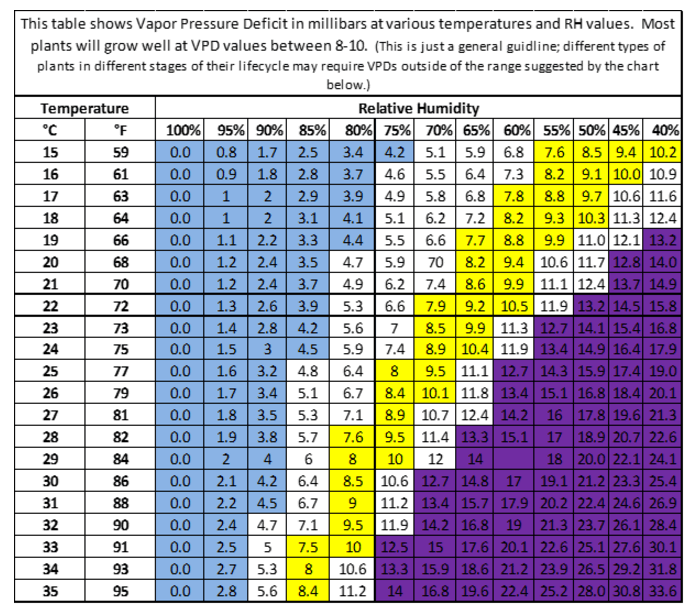In order to learn how to create the best environment for your particular crop it is helpful to understand how temperature, humidity, and the relationship between the two affect your plants. To fully understand that relationship we must understand the cycle of water movement through plants.
The best fertilizer is (drum roll please)…UNICORN DUST! O.K. let’s be real, there is no more a best fertilizer than there are actual factual unicorns. What is ideal or best is always relative, i.e. what you are growing, your light levels, your growing environment etc. That said, for something like one’s growing environment there are a broad range of conditions; temperature, humidity, CO2 levels in which plants will grow. There is a difference however between surviving and thriving; what environmental conditions are ideal to make your plants thrive is determined by your specific crop. In order to learn how to create the best environment for your particular crop it is helpful to understand how temperature, humidity, and the relationship between the two affect your plants. To fully understand that relationship we must understand the cycle of water movement through plants.
Water is absorbed by the roots from the soil or growing medium and is transported in a liquid state throughout the plant via the xylem. The xylem not only transports water but it also acts as storage for water and water-soluble nutrients in vascular plants. Vascular plants are able to grow higher than other plants due to the rigidity of xylem cells, which support the plant. This is why when a plant experiences a severe drought it wilts; without the internal water pressure it can’t support itself. Of all the water that is absorbed by a plant less than 5% remains in the plant for growth. The remaining 95% escapes as water vapor through a process called transpiration.
Transpiration is on ongoing process; water is continuously evaporating from the surface of leaf cells exposed to air. As the water evaporates more water is absorbed by the roots to replace it. The water forms what could be considered a column within the plant. Due to the unique cohesive property of adjacent hydrogen molecules (water is composed of 2 hydrogen molecules and 1 oxygen molecule) water is effectively “pulled-up” through the plant as the water molecules evaporate from the leaves.
The process of transpiration is much more complex than simple water movement. Transpiration also effects a plant’s temperature regulation, nutrient absorption, and CO2 intake. When water evaporates, changing from a liquid state to a gaseous state, energy (in the form of heat) is absorbed. This results in a cooling effect known as evaporative cooling allowing the plant to regulate its temperature. Additionally, as more water is absorbed by the plant to replace the evaporating water dissolved nutrients vital to the plants growth are given the opportunity to enter the root system. Lastly, when a plant is transpiring its stomata (leaf cells that regulate gas exchange) are open. When stomata are open they both release water vapor and also allow vital CO2 to enter.
So, why the lesson in hydrodynamics? That is because the ideal temperature and humidity for growing plants is GREATLY influenced by water. As temperatures increase the air is capable of holding more water vapor. We measure the capacity of air to hold water vapor with a metric called relative humidity (RH.) RH is expressed as a percentage; a RH of 45% means that the air at the current temperature is saturated with 45% of the water vapor it could possibly hold. As the relative humidity increases it effects the transpiration of a plant which in turn affects the plant’s ability to regulate its temperature, access nutrients, and absorb CO2. A hydrated leaf would have a RH of 100%, anything less than 100% RH in the atmosphere creates an opportunity for water to move from the leaves into the atmosphere. The lower the RH the less moisture is in the atmosphere and therefore the greater the driving force for transpiration.
The interconnected nature of temperature and humidity is best discussed as vapor pressure deficit. Vapor Pressure Deficit (VPD) is the difference in the pressure exerted by water vapor in the air at saturation (100% RH at a given temperature) and the pressure exerted by the water vapor that is actually being held in the air at the same temperature. Think of VPD the atmospheric demand for moisture. VPD values are the inverse of RH; that is to say when RH values are high VPD is low (lots of moisture in the air equates to less demand for moisture in the atmosphere.) So, the higher the VPD the more moisture the air can pull from your plants. Most plants will grow well at a VPD between 8-10 millibars. VPD can be used to accurately define an ideal RH for a specific temperature.
See the below chart:

There is no magic dust to make a bad grower into a good one, but understanding the principles of water movement, temperature, relative humidity, and vapor pressure deficit will surely make you a better grower. So if you want to know the ideal temperature and humidity know your VPD!